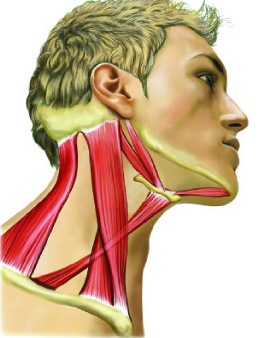Balance in the human body, is important in many different ways including the balance needed between different muscle groups. This applies to all parts of the body and especially the neck, a place where many people experience pain and tightness.
For example, since there are muscles in both the front and back of the neck, what is optimal for your body that these muscles are equal in strength. If they are unbalanced then problems can be exacerbated.
What occurs as an inevitable result of bad posture and/or previous injury is the muscles in the back of the neck assume responsibility for not only their role but also the role of the muscles in the front of the neck. With more work to do, the back of the neck gets tired, fatigued and sore.
Through Applied Kinesiology and a skillful application of manual muscle testing I frequently witness a dysfunction of the sternocleidomastoid mucles, or the SCMs (highlighted in picture). They anchor the skull and jaw down into the collar bone and upper ribs. This dysfunction doesn’t mean that the muscles or nerves are broken, but merely that they are not functioning optimally.
Weak front neck muscles result in overworked back neck muscles. When the neck is imbalanced pain persists to keep one from moving in such a way that would lead to further damage of the tissues of the spine and that which it innately protects, the precious spinal cord. In a sense, the body goes into “lockdown” mode to protect itself.
The human body is intelligently designed to maintain balance, not just for the sake of avoiding falls or enjoying a surfboard on a wave, but to keep joints from being injured, damaged and inflamed. As a chiropractic student, pursuing certification in Applied Kinesiology, I needed a biomechanical definition of homeostasis, one that encompassed the ability of joints of the body to withstand the stresses from without. Arthur Guyton’s definition rang true: the inherent balance of a biological system. As I work with patients who have ankle pain, shoulder pain, neck pain and lower back pain etc., I assume the responsibility of facilitating a return to homeostasis, normalcy, and balance of each joint of the body. When a joint is balanced pain often decreases, for there is no longer a need to deter the person from using the joint fully.
To better understand how balanced muscles play into the health of joints lets look at the elbow. The biceps pulls the forearm up to bring a cup to our lips and then the triceps pulls the forearm down to the rest the cup back on the table. However, in this simple motion much more is at play. As the bicep pulls the triceps must also relax, or else the movement becomes hindered. Such inefficient movement is termed a “reduced range of motion,” and may be something health care professionals have spoken to you about.
In order for a joint to utilize it’s full range of motion the muscles that pull it one direction must be able to do so while those muscles naturally in opposition must be fully relaxed. To further illustrate the complexity of joint balance lets consider a golfer’s swing. To propel the club, the muscles of the chest and abdominals must contract, or shorten, quickly and powerfully.
During that contraction the muscles of the back, which naturally oppose the chest and abdominal muscles, are relaxed. However, after the ball has been propelled (hopefully onto the green) opposing muscles contract themselves to slow the movement of the arm, protecting the shoulder and spine.
Interestingly enough, the majority of golfers I see have pain in their back and the back of their shoulders, not their chest. This pain is easily resolved through balancing the muscles and joints of the shoulder and trunk.
It is common to hear of people who store all their stress in their neck, but what does that mean? Lets unpack it. The skull weighs about as much as a small bowling ball and requires, during waking hours, consistent support from the muscles of the neck. Holding stress in the back of the neck is a sign that the front of the neck is not doing its job well.
I encourage all of my patients and readers to see exercise, diet, self care, rest and therapies all as investments in their health. If the muscles of your neck are going to be supporting your noggin for 18 hours a day, would it not be worth making sure that they are best able to do their job?
— Dr. Joshua Wright

